Independent Albania
Independent Albania (Albanian: Shqipëria e Pavarur) was a parliamentary state declared in Vlorë (at the time part of Ottoman Empire) on 28 November 1912 during the First Balkan War. Its assembly was constituted on the same day while its government and senate were established on 4 December 1912.
Albania | |||||||||||||||||
|---|---|---|---|---|---|---|---|---|---|---|---|---|---|---|---|---|---|
| 1912–1914 | |||||||||||||||||
.svg.png.webp) Flag
 Coat of arms
| |||||||||||||||||
| Anthem: Himni i Flamurit "Hymn of the Flag" | |||||||||||||||||
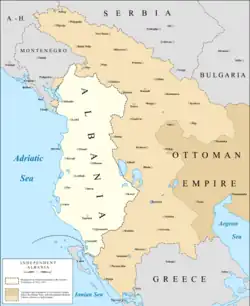 Map of the de jure boundaries of Albania according to the London Conference (1913) in white | |||||||||||||||||
| Status | Former unrecognized country | ||||||||||||||||
| Capital | Vlora | ||||||||||||||||
| Common languages | Albanian | ||||||||||||||||
| Religion | Islam, Christianity, etc. | ||||||||||||||||
| Demonym(s) | Albanian | ||||||||||||||||
| Government | Parliamentary republic under a provisional government | ||||||||||||||||
| Head of State | |||||||||||||||||
• 1912–14 | Ismail Qemali | ||||||||||||||||
| Prime Minister | |||||||||||||||||
• 1912–1914 | Ismail Qemali | ||||||||||||||||
| Legislature | Assembly of Vlorë | ||||||||||||||||
• Upper house | Senate of Albania | ||||||||||||||||
| History | |||||||||||||||||
| 28 November 1912 | |||||||||||||||||
| 21 February 1914 | |||||||||||||||||
| Currency | Lek | ||||||||||||||||
| |||||||||||||||||
The delegation of Albania submitted a memorandum to the London Conference of 1913 requesting international recognition of independent Albania. At the beginning of the conference it was decided that the region of Albania would be under Ottoman suzerainty but with an autonomous government. The requests by the delegation for recognition based on the ethnic rights of Albanians were rejected and the treaty signed on 30 May 1913 partitioned a major part of the claimed lands between Serbia, Greece and Montenegro, leaving as independent territory only a central region, which was put under the protection of the Great Powers. The ambassadors of six Great Powers met again on 29 July 1913 and decided to constitute a new state, the Principality of Albania, as a constitutional monarchy. Finally, with the Treaty of Bucharest being signed in August 1913, this new independent state was established, leaving about 40%[1] of the ethnic Albanian population outside its borders.
Name
The name of the state used in the text of declaration of independence of Albania is Shqipëria (English: Albania).[2] It is also referred to as the "independent Albania" (Albanian: Shqipëria e Mosvarme),[3] the "Albanian State"[4] (Albanian: Shteti Shqiptar) or the "independent state of Albania"[5][6] (Albanian: Shteti i pavarur shqiptar).[7]
Political system
The independent Albania established on 28 November 1912 is the first Albanian state in modern history.[8] It was a parliamentary state.[9] Some sources refer to it as the Republic of Albania[10][11] or the Albanian Republic.[12]
Albania became an independent state through four constitutional decisions of the Assembly of Vlorë made on 28 November 1912:[13]
- Albania, as of today, should be on her own, free and independent
- under a provisional government
- that a council of elders (senate) be elected to assist and supervise the government
- a commission is to be sent to Europe to defend Albanian interests among the Great Powers
Territory
The authority of the state was limited to the regions of Vlore, Berat and Lushnje.[14] The claimed territory was much larger than the territory of contemporary Albania and than the territory over which the Provisional Government exercised its power. It comprised the territories of Kosovo Vilayet, Monastir Vilayet, Shkoder Vilayet and Janina Vilayet.[15] The Treaty of London, signed on 30 May 1913, reduced the territory of Albanian state to its central regions after partitioning a significant part of territory claimed by Albania between the Balkan allies (a major part of the northern and western area was given to the Serbia and Montenegro while the southern region of Chameria became part of Greece).[16] Kosovo was given to Serbia at the London treaty at the insistence of Russia.[17]
During the First Balkan War the kingdoms of Greece, Serbia, Bulgaria and Montenegro aspired to incorporate the entire region into their states (completely denying the Albania's independence), so most of the captured territory was occupied by their armies. Independent Albania did however exercise control over one pocket of land which included Vlore, Berat, Fier and Lushnje.[18]
History
Albanian Vilayet

Until September 1912, the Ottoman government intentionally kept Albanians divided within four ethnically heterogeneous vilayets to prevent Albanian national unification.[19] The reforms introduced by the Young Turks provoked the Albanian Revolt of 1912 which lasted from January to August 1912.[20] In January 1912, Hasan Prishtina, Albanian deputy in the Ottoman parliament, publicly warned members of the parliament that the policy of the Young Turks' government would lead to a revolution in Albania.[21] The Albanian revolt was successful and until August 1912 rebels managed to gain control over whole Kosovo vilayet (including Novi Pazar, Sjenica, Pristina and even Skopje), a part of the Scutari Vilayet (including Elbasan, Përmet and Leskovik), Konitsa in Janina Vilayet and Debar in Monastir Vilayet.[22] The Ottoman government ended the Albanian revolt on 4 September 1912 by accepting all demands related to establishing an unified autonomous system of administration and justice for Albanians within one vilayet—the Albanian vilayet.[23][24]
First Balkan War
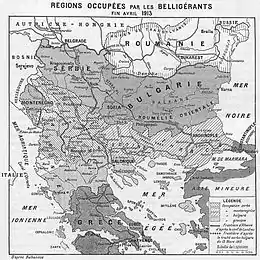
The success of the Albanian revolt sent a strong signal to the neighbouring countries that the Ottoman Empire was weak.[25] Besides, the Kingdom of Serbia opposed the plan for an Albanian vilayet, preferring a partition of the European territory of the Ottoman Empire among the four Balkan allies.[26] In the meantime it was agreed that the conquered territory was to have the status of a condominium.[27]
Albanian leaders, including Faik Konitza and Fan Noli, organized a large meeting on 7 October 1913 in Boston. They decided that Albanians should "unite fully with the Ottoman government against the enemies of the Empire" because "if Turkey is defeated, the Balkan states would shred Albania."[28] That decision was risky, because if the Ottomans were defeated, Albanian participation in the Balkan war on the Ottoman side would serve as justification for the Balkan allies to partition Albania as an Ottoman province.[29] Albanians who were mobilized in the Ottoman army fought for their country rather than for the Ottoman Empire.[30]
During the First Balkan War the combined armies of the Balkan allies overcame the numerically inferior and strategically disadvantaged Ottoman armies and achieved rapid success. They occupied almost all the remaining European territories of the Ottoman Empire including the territory of the Albanian Vilayet.[31]
At the beginning of November 1912, Albanian leaders appealed to Emperor Franz Joseph I of Austria-Hungary, explaining the difficult situation in their country because parts of the four vilayets were also claimed by the Balkan League who were present on the disputed lands.[32] Austria-Hungary and Italy strongly opposed the arrival of Serbian army on the Adriatic Sea because they perceived it as a threat to their domination of the Adriatic and feared that a Serbian Adriatic port could become a Russian base.[33] Ismail Kemal, who had been an Albanian deputy in the Ottoman parliament, secured the support of Austria-Hungary for the autonomy of Albania within the Ottoman Empire, but not for its independence.[34]
All-Albanian Congress
Ismail Kemal invited the representatives of all parts of Albanian Vilayet to attend the All-Albanian Congress[35][36] held in Vlorë on November 28, 1912.[37] At the beginning of the session, Kemal referred to the threatened Albanian rights gained during the Albanian revolts in the previous four years, and explained to the participants of the congress that they should do whatever was necessary to save Albania.[38] After his speech they began by checking the documents[39] because it was decided that each kaza of Albanian Vilayet would be counted as one vote, regardless of the number of its delegates.[40] Participants of this congress are regarded as Founding Fathers of Albania.
After the declaration of independence

The first notification about the proclaimed independence was sent to the command of Serbian Army in Ohrid.[41] On 29 November 1912, the army of the Kingdom of Serbia captured Durrës without any resistance and established Durrës County with four districts (Serbian: срез): Durrës, Lezha, Elbasan and Tirana.[42][43] New Serbian authorities were faced with big difficulties in governing a new county because all secluded army garrisons with small number of soldiers were destroyed in a couple of days.[44] Although some tribal chieftains proposed to organize an armed resistance against troops of Serbia in the occupied parts of Albania, the provisional government of the Independent Albania decided to avoid unnecessary casualties and concluded agreement (besa) to maintain harmony in occupied territory.[45]
The international relations of Albania began to function on a state level after it was proclaimed independent and the first diplomatic efforts of its government were requests for the international recognition of the Albanian state.[46] In December 1912, a delegation of Albania submitted a memorandum to the London Conference of 1913 insisting on the ethnic rights of Albanians and requested an international recognition of the independent Albania composed of Kosovo, western Macedonia including Skopje and Bitola and the whole territory of Epirus up to Arta.[47]
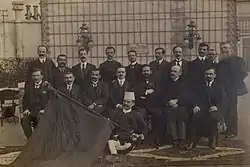
About 120 notable politicians and intellectuals from Albania attended the Albanian Congress of Trieste from 27 February to 6 March 1913 and requested from the Great Powers a recognition of the political and economical independence of Albania.[48][49] Isa Boletini and Ismail Kemal travelled to London in March 1913 to obtain Britain's support for their new country.[50] On March 6 Ioannina was captured by forces of the Kingdom of Greece.[51] In March 1913 a group of 130 (or 200) soldiers of the Kingdom of Serbia were killed near Prizren by Albanian irregulars in act of revenge for repression of Serbian army.[52]
In April 1913 the army of the Kingdom of Serbia retreated from Durrës but remained in other parts of Albania. On the other hand, Kingdom of Montenegro managed to capture Shkodër on 23 April 1913 after six months of siege. However, when the war was over, the Great Powers did not award the city to the Kingdom of Montenegro, which was compelled to evacuate it in May 1913.
In May 1913, delegates of Albania in London requested a British sovereign and considered offering the Albanian throne to Aubrey Herbert.[53]
London Treaty

The Great Powers did not fulfil the requests for recognition of Albania.[54] At the beginning of the London conference in December 1912 the ambassadors of all six Great Powers rejected the plan for establishing an independent Albania.[55] Instead, they decided that Albania would be under Ottoman suzerainty but with an autonomous government.[56] After it became obvious that Ottoman Empire would lose all of Macedonia and its territorial connection with Albania, the Great Powers realized they had to change their decision.[57]
The Treaty of London, signed on 30 May 1913, partitioned significant part of territory claimed by Albania, regardless its ethnic composition, between the Balkan allies reducing the territory of Albania to its central regions.[58]
After the London treaty
In September 1913 independent Albania secretly supported and helped Ohrid–Debar Uprising because Ismail Kemal thought that independent Albania was too weak to openly confront the Kingdom of Serbia.[59] Kemal ordered a simultaneous attack of the Albanian forces led by Isa Boletini and Bajram Curri to the region of Prizren.[60] Peshkopi was captured on 20 September 1913.[61] Local Albanians and Bulgarians expelled the Serbian army and officials, creating a front line 15 km east of Ohrid. A local administration was set up in Ohrid.[62] The Serbian Army of 100,000 regulars suppressed the uprising in several days. Thousands were killed, and tens of thousands of local inhabitants fled for Bulgaria and Albania to save their lives. According to the Report by the International Commission of the Carnegie Endowment for International Peace the number of Albanians who took refuge was 25,000.[63]
On 16 October 1913, Essad Pasha Toptani—who also had been an Albanian deputy in the Ottoman parliament—established the Republic of Central Albania with its administrative centre in Durrës.[64] Toptani's state was also short-lived and unrecognised, with its territory bounded by rivers Mat in the North and Shkumbin in the South. It further partitioned already truncated territory of Albania. Toptani contested the status of the provisional government and denied that Kemal's government was legitimate, emphasizing that it was "the personal creation of a number of men."[65][66] In July 1913 Ismail Kemal attempted to calm Toptani by appointing him Minister of Interior, but with no avail.[67] Toptani was also, like Kemal little earlier, forced by Great Powers to step away on 1 February 1914.[68]
Politics

Declaration of Independence
At the beginning of the session Ismail Kemal emphasized that the only way to prevent division of the territory of Albania between the Balkan allies was to establish it as independent state, separated from Ottoman Empire.[69] Kemal's proposal was unanimously accepted and it was decided to sign the declaration of independence of Albania in the name of the constituted Assembly of Vlorë (Albanian: Kuvendi i Vlorës) which members were representatives of all the regions of Albania.[70] By the declaration of Albanian independence the Assembly of Vlorë rejected the autonomy granted by the Ottoman Empire to the Albanian Vilayet, projected a couple of months earlier.[71] The consensus was made for the complete independence.[72]
In Vlora, on the 15th/28th of November 1328/1912.
Following the speech made by the President, Ismail Kemal Bey, in which he spoke of the great perils facing Albania today, the delegates have all decided unanimously that Albania, as of today, should be on her own, free and independent.[73]
The sitting was then suspended and members of newly constituted National Assembly went to the house of Ismail Kemal who raised the flag of Skanderbeg on the balcony of his house, in front of the gathered people.[74]
Government and Senate
The establishment of the government was postponed for the fourth session of the Assembly of Vlorë, held on 4 December 1912, until representatives of all regions of Albania arrived to Vlore.[75] During that session members of the assembly established the Provisional Government of Albania.[76] It was a government that consisted of ten members, led by Ismail Kemal, until his resignation on 22 January 1914.[77] Assembly established the Senate (Albanian: Pleqësi) with advisory role to the government, consisted of 18 members of Assembly.[78]
Ismail Kemal was appointed as the first prime minister of independent Albania.[79] On the same session held on 4 December 1912 the assembly appointed the other members of the government:[80]
- Prime Minister (and de facto head of the state): Ismail Kemal
- Deputy Prime Minister: Dom Nikollë Kaçorri
- Minister of Foreign Affairs (provisionally): Ismail Kemal
- Minister of Internal Affairs: Myfit Bej Libohova (in July 1913 Essad Pasha Toptani)
- Minister of War: General Mehmet Pashë Derralla (from Tetovo in Macedonia)
- Minister of Finance: Abdi Toptani
- Minister of Justice: Petro Poga
- Minister of Education: Luigj Gurakuqi
- Minister of Public Services: Mit’hat Frashëri (from Ioannina in Greece)
- Minister of Agriculture: Pandeli Cale
- Minister of Posts and Telegraphs: Lef Nosi
Public services
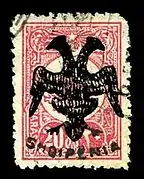
A week after the independent Albania was proclaimed, its first Ministry of Posts and Telegraphs was established with Lef Nosi as its minister. Independent Albania took over the Ottoman post offices and placed significant efforts to make the Albanian postal service identifiable.[81] Post offices of the independent Albania used the Ottoman postal seals until the end of April and the beginning of May 1913, when they were replaced by the postal seals of Albania with the name of the place in the upper part of the seal and the name of the state, Albania (Shqipenie), in the bottom part.[82] On 5 May 1913 the first postage stamps of Albania were put into circulation. On 7 July 1913 Albania submitted an official request to the Universal Postal Union (UPU) for membership.[83] The request was rejected, and Albania would become a member of UPU only in 1922.[84]
After Albania achieved its independence from the Ottoman Empire in 1912, its legal system continued to function under the Ottoman Civil Code (Mejelle) for some time.[85]
Since 28 November 1912 until 1926 the Albanian government did not mint any currency. Transactions occurred in gold and silver coins of other countries, whereas the official unit of account was the franc of the Latin Monetary Union.[86]
Until 1912, the education system in Albania depended on religious institutions. Muslims attended Ottoman schools, the Orthodox population attended Greek or Armenian schools, Catholics attended Italian or Austrian schools, whereas in the districts near Slavic states, the population attended Serbian or Bulgarian schools.[87] When Albania was declared independent in 1912 its government took measures to close foreign schools and to open Albanian ones.[88] From 1912 to 1914, there was not much opportunity and time for progress of national education, because of the political instability and the breakout of World War I.[89] The first laic school was opened in Shkoder in 1913.
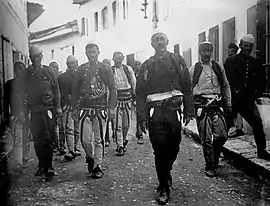
A group of fighters from Kosovo led by Isa Boletini were the first nucleus of the armed forces of Albania[90] established on 4 December 1912.[91] The Ottoman forces backed the government of Independent Albania until the beginning of 1913, although the Ottomans did not recognize its independence.[45]
Law enforcement forces (gendarmerie and Albanian Police) of the independent Albania were established on 13 January 1913.[92] About 70 former Ottoman officers were engaged as officers of the law enforcement units of the independent Albania. The first director of the Albanian Police was Halim Jakova-Gostivari, whereas the first commanders of the gendarmerie were Alem Tragjasi, Hysni Toska, Sali Vranishti, and Hajredin Hekali. The Albanian Police uniforms was colored in gray and green, and the collars were red and black.[93]
Economy
The economy of Albania after it became independent state in 1912 was based on primitive agriculture and livestock, with no significant industry, and little international trade.[94] Starting in 1912, Albania began activities aimed at implementing an agrarian reform, which would transfer ownership of the arable land from the big landowners to the peasants.[95]
Aftermath

The Treaties of London and Bucharest dealt with the final territorial adjustments arising out of the conclusion of the Balkan Wars.[96] After the London treaty has been signed the ambassadors of six Great Powers decided to constitute a new state, Albania, as hereditary principality.[97][98]
Point 1. Albania is constituted as an autonomous, sovereign and hereditary principality by right of primogeniture, guaranteed by the six Powers. The sovereign will be designated by the six Powers.[99]
— Decision of the ambassadors of the six Great Powers made on 29 July 1913 during 54th meeting of the Conference of the Ambassadors
The Great Powers refused to recognize the Provisional Government of Albania and, instead, organized the International Commission of Control (ICC) to take care of the administration of the newly established principality until the arrival of the new monarch.[100][101] The first law enforcement agency of the new principality was the International Gendarmerie.
The treaty of Bucharest, signed on 10 August 1913, established internationally recognized Albania as an independent state.[102] The creation of Albanian state in 1913[103] after the Balkan Wars was their only political result.[104]
A plot by the Young Turk government and led by Bekir Fikri to restore Ottoman control over Albania through the installment of an Ottoman-Albanian officer Ahmed Izzet Pasha as monarch was uncovered by the Serbs and reported to the ICC.[105][106][107] Ismail Kemal supported the plot for military assistance against Serbia and Greece.[108][105][109] The ICC allowed their Dutch officers serving as the Albanian Gendarmerie to declare a state of emergency and stop the plot.[106][108][107] They raided Vlorë on 7–8 January 1914, discovering more than 200 Ottoman troops and arrested Fikri.[106][105][110] During Fikri's trial the plot emerged and an ICC military court under Colonel Willem de Veer condemned him to death[110] and later commuted to life imprisonment,[106] while Kemal and his cabinet resigned.[108] After Kemal left the country, turmoil ensured throughout Albania.[111]
After a display of independence of Kemal's government, the Great Powers were angered and the International Commission of Control forced Kemal to step aside and leave Albania.[112]
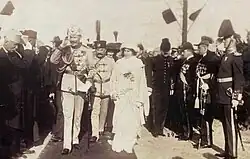
In 1914, after a gradual assumption of the administration of the country, the International Commission of Control prepared a draft of the constitution (Albanian: Statuti Organik) with 216 articles. It was a basis for establishment of the National Assembly with power of legislation in Albania, which was designed as a hereditary constitutional monarchy.[113] According to the constitution, the new principality would have, with few exceptions, the same administrative organization as during the Ottoman Empire suzerainty.[114] It would be partitioned on seven administrative districts, each of which would choose three representatives for the national assembly by direct suffrage. The prince would nominate ten representatives and the heads of the all three religions (Islam, Orthodox and Catholic) would be also representatives in the national assembly, which would have four-year terms. The Council of Ministres, with executive powers, would be appointed by the prince.[115] After monarchical form of government has been installed by the International Commission of Control in 1914 the political system of Albania became a monarchy.[116]
The biggest group of Albanians who were left outside of the new state were Albanians from Kosovo, the cradle of the 19th century Albanian nationalism.[117] Nazi Germany and Fascist Italy exploited the discontent of the Albanians about the inaccurate ethnic borders.[118]
Commemorations

(English: 100 years of the Albanian state)
Since Albania was declared independent on November 28, 1912,[119] every 28 November is commemorated by all Albanians (wherever they live in the world) as their Independence Day.[120] In the Republic of Albania, the day is celebrated as a public holiday. In the Republic of Kosovo, the day has been an official public holiday since a 2011 decision of Prime Minister Hashim Thaçi's cabinet.[121]
The proceedings of the conference dedicated to the 70th anniversary of Albania's independence organized in November 1982 by the Academy of Sciences of Albania were entitled "National forces against imperialist dictate in the organization of the Albanian State, 1912-1914: Report".[122] In 1992 the Academy of Sciences of Albania organized a conference dedicated to 80th anniversary of independent Albania and published a document titled: "The organization of government, judicial system and military of Albania (1912-1914)".[123] Year 2012 is a year of the centennial of the Independence of Albania.[124] The opening day of the year-long celebration was on 17 January 2012 during a solemn ceremony held at the Parliament of Albania and attended by Albanian representatives from the Republic of Kosovo, Macedonia, Montenegro, Preševo and Bujanovac, who were joined that day like they were 100 years ago.[125]
The Ministry of Tourism, Cultural Affairs, Youth and Sports announced on 22 December 2011 the "International Competition for the accomplishment in sculpture of the monumental work dedicated to the “100 anniversary of the Declaration of Independence of the Albanian State: 28 November 1912 – 28 November 2012”".[126]
Gallery
 16 June 1913
16 June 1913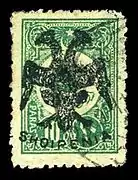 16 June 1913
16 June 1913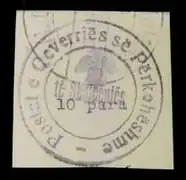 25 October 1913
25 October 1913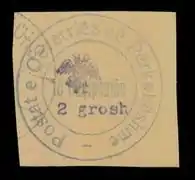 25 October 1913
25 October 1913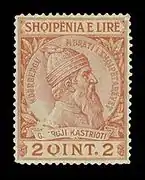 1 December 1913
1 December 1913
References
- Elsie 2010, p. lix: "... about 30 percent of the Albanian population were excluded from the new state/about 40% ..." p. 243: "found themselves excluded from this new country"
- Islami, Selim; Frashëri, Kristo; Buda, Aleks (1968), Historia e popullit shqiptar (in Albanian), Prishtinë: Enti i botimeve shkollare i Republikës Socialiste të Serbisë, p. 352, OCLC 1906502,
Propozimet e kryetarit u aprovuan njëzëri e me entusiazëm nga delegatët, te cilët nënshkruan dokumentin historik ku thuhej: „ . . . Shqipëria me sot te bahet ne vehte, e lire ee mosvarme."
- Pirraku, Muhamet (19 April 2009). "Cili Është Mesazhi I Emërtimeve "SHQIPËRIA SHTETËRORE"". AlbaniaPress.com : Agjensia Informative Shqiptare. Archived from the original on 31 March 2020. Retrieved 18 February 2012.
Shteti i projektuar nga Konferenca e Ambasadorëve në Londër, më 1913, si: "Principata e Shqipërisë" me shtrirjen vetëm në një pjesë të Bregdetit shqiptar, ... të më pak se një e treta e tokave të shtetit "Shqipëria e Mosvarme" e shpallur në Vlorë, më 28 nëntor 1912 (State designed by the Conference of Ambassadors in London in 1913, as: "The Principality of Albania" ... is less than a third of the territory of "Independent Albania" declared in Vlora, on November 28, 1912)
- Puto, Arben; Academy of Sciences of Albania (1983), National forces against imperialist dictate in the organization of the Albanian State, 1912-1914, Tirana: "8 Nëntori" Pub. House, OCLC 11497570
- Jansen, Suzanne (August 2006), The Kosovo Status Negotiations in 2006 (PDF), Amsterdam: Universiteit van Amsterdam, p. 50,
The Proclamation of the Independent State of Albania, 1912
- Zolo, Danilo (2002), Invoking humanity : war, law, and global order, London: Continuum, p. 179, ISBN 978-0-8264-5656-4, OCLC 47844508,
In November 1912 the independent state of Albania was proclaimed at Vlore
- Omari, Luan (1994), "Shteti i pavarur shqiptar në vitet 1912-1914 [Independent state of Albania in the years 1912-1914]", Historia e shtetit dhe e së drejtës në Shqipëri [History of state and law in Albania] (in Albanian), vol. 2, Tiranë: Shtëpia Botuese Luarasi, OCLC 164822827,
Shteti i pavarur shqiptar në vitet 1912-1914 [Independent state of Albania in the years 1912-1914]
- Sokalski, Henryk J (2003). An ounce of prevention: Macedonia and the UN experience in preventive diplomacy. Washington, D.C.: United States Institute of Peace Press. p. 60. ISBN 9781929223466. Retrieved 9 February 2012.
The first Albanian state in modern history emerged in 1912.
- Barjaba, Kosta (2004), Albania's democratic elections, 1991-1997 : analyses, documents and data, Berlin: Edition Sigma, p. 188, ISBN 978-3-89404-237-0, OCLC 57567449,
... the first independent Albanian state was conceived as a parliamentary state.... the High Council ... was elected by the Assembly...Thus, the first Albanian state can be seen as a parliamentary state and not as a monarchy.
- Gingeras, Ryan (2009), Sorrowful shores : violence, ethnicity, and the end of the Ottoman Empire, 1912-1923, Oxford: Oxford University Press, ISBN 978-0-19-956152-0, OCLC 251212020,
the declaration of Republic of Albania in 1912
- Greville Pounds, Norman John (1969), Eastern Europe, Chicago: Aldine Pub. Co, p. 819, ISBN 9780582481435, OCLC 5671,
... policy of seeking autonomy within it was no longer practical. The Albanian leaders therefore turned to one off seeking complete independence and in November 1912 proclaimed the Republic of Albania
- R King, Robert (1973), Minorities under communism; nationalities as a source of tension among Balkan Communist states, Cambridge: Harvard University Press, p. 140, ISBN 978-0-674-57632-2, OCLC 736902,
... the Albanian Republic was proclaimed in 1912)...
- Universiteti Shtetëror i Tiranës; Instituti i Historisë dhe i Gjuhësisë, Universiteti Shtetëror i Tiranës; Instituti i Gjuhësisë dhe i Letërsisë, Universiteti Shtetëror i Tiranës; Instituti i Historisë (Akademia e Shkencave e RPS të Shqipërisë); Instituti i Gjuhësisë dhe i Letërsisë (Akademia e Shkencave e RPS të Shqipërisë); Seksioni e Shkencave Shoqërore (2004), "Essential Characteristics of the State (1912 - 1914)", Studia Albanica, vol. 36, Tirana: L'Institut, p. 18, OCLC 1996482,
Albanian state started its independent life through four important constitutional decisions that we already know: 1. Albania must become independent and free 2. ... under a temporary government 3. A group of Wise Men have to be elected for supporting and controlling the government 4. A Commission has to be sent to Europe in order to represent the Albanian issue in front of the great Kingdoms
- Pavlowitch, Stevan K. (1999). A history of the Balkans, 1804-1945. London: Longman. p. 173. ISBN 9780582045859.
The contested authority of Qemal's government was limited to a triangle of territory between Vlore, Berat and Lushnje
- Eberhardt, Piotr (2003), Ethnic groups and population changes in twentieth-century Central-Eastern Europe : history, data, and analysis, Armonk, N.Y.: M.E. Sharpe, p. 356, ISBN 978-0-7656-0665-5, OCLC 48383528,
The Albanian state at this time was larger than its counterpart today and comprised territories belonging to the former Turkish provinces (vilayets) of Shkoder,... Skopje,...Bitola,... and Janina...
- Vickers 1999, p. 70
... the Conference nevertheless awarded the Balkan allies large areas of Albanian-claimed territory... A major part of northern and western Albania went to Serbia and Montenegro, while Greece received the large southern region of Chameria, leaving the Albanian state reduced to the central regions ...
- Rakowska-Harmstone, Teresa; Dutkiewicz, Piotr; Orzelska, Agnieszka (2006), New Europe : the impact of the first decade, vol. 2, Warsaw: Institute of Political Studies; Polish Academy of Sciences, p. 37, ISBN 978-83-88490-87-3, OCLC 749805563,
Kosovo was included in the independent Albania in 1912, but was given to the Serbs under the 1913 Treaty of London at Russia's insistence.
- Filipović, Gordana; Milosavljević, Margot; Milosavljević, Boško; Kveder, Kordija; Hrgović, Milica; Zorić, Kristina; Petnički, Zvonko (1989), Kosovo-past and present, Belgrade: Review of International Affairs, p. 71, OCLC 440832915, retrieved 3 February 2012,
The provisional government of Ismail Kemal held power only in Vlore Berat, Fier and Lushnje
- Hidryma Meletōn Chersonēsou tou Haimou (1967), Balkan studies: biannual publication of the Institute for Balkan Studies, vol. 8, Thessaloniki: The Institute for Balkan Studies, p. 30, OCLC 1519050,
Ottoman government, although purposely keeping Albanians administratively divided into separate, ethnically non-homogeneous vilayets, in order to prevent any unification and national development...
- Gurakuqi, Romeo (November 2007). "The Highland Uprising of 1911". Shoqata Dedë Gjo' Luli Association. Archived from the original (php) on July 25, 2011. Retrieved January 9, 2011.
It was provoked by the laws passed by the new regime that claimed to loyally implement the old fiscal policy on the extremely impoverished population, impose new heavy taxes upon people, forcefully recruit Albanians for the Turkish army, continue the process of the entire population disarmament, extend its absolute power all over Albania, even over those regions that had always enjoyed certain privileges.
- Zhelyazkova, Antonina (2000). "Albania and Albanian Identities". International Center for Minority Studies and Intercultural Relations. Archived from the original on September 27, 2011. Retrieved January 10, 2011.
At a parliamentary session in January 1912, ... Albanian deputy Hasan Prishtina warned that the reactionary policy of the Young Turks' government was going to lead to a revolution in Albania.
- Bogdanović, Dimitrije (November 2000) [1984]. "Albanski pokreti 1908-1912.". In Antonije Isaković (ed.). Knjiga o Kosovu (in Serbian). Vol. 2. Belgrade: Serbian Academy of Sciences and Arts. Retrieved January 9, 2011.
... ustanici su uspeli da ... ovladaju celim kosovskim vilajetom do polovine avgusta 1912, što znači da su tada imali u svojim rukama Prištinu, Novi Pazar, Sjenicu pa čak i Skoplje... U srednjoj i južnoj Albaniji ustanici su držali Permet, Leskoviku, Konicu, Elbasan, a u Makedoniji Debar...
- Shaw, Stanford J.; Ezel Kural Shaw (2002) [1977]. "Clearing the Decks: Ending the Tripolitanian War and the Albanian Revolt". History of the Ottoman Empire and modern Turkey. Vol. 2. United Kingdom: The Press Syndicate of University of Cambridge. p. 293. ISBN 978-0-521-29166-8. Retrieved January 10, 2011.
Therefore, with only final point being ignored, on September 4, 1912 the government accepted proposals and the Albanian revolt was over
- Elsie 2010, p. 367: "PRESIDENT: Ismail Qemal Bej Vlora, who declared Albanian independence in 1912, was the first acting head of state and therefore might be regarded as the country's first president."
- Warrander, Gail; Verena Knaus (November 2007). Kosovo. United States of America: The Globe Pequot Press. p. 12. ISBN 978-1-84162-199-9.
At the same time the rebellion sent strong signal to Kosovo neighbors that the Ottoman Empire was weak.
- Josef Redlich; Baron d'Estournelles; M. Justin Godart; Walter Shucking; Francis W. Hirst; H. N. Brailsford; Paul Milioukov; Samuel T. Dutton (1914). "Report of the International Commission to Inquire into the Causes and the Conduct of the Balkan Wars". Washington D.C.: Carnegie Endowment for International Piece. p. 47. Retrieved January 10, 2011.
The Servians hastened to oppose the plan of a "Greater Albania" by their plan for partition of Turkey in Europe among the Balkan States into four spheres of influence.
- Josef Redlich; Baron d'Estournelles; M. Justin Godart; Walter Shucking; Francis W. Hirst; H. N. Brailsford; Paul Milioukov; Samuel T. Dutton (1914). "Report of the International Commission to Inquire into the Causes and the Conduct of the Balkan Wars". Washington D.C.: Carnegie Endowment for International Piece. p. 49. Retrieved January 10, 2011.
In a few weeks the territories of Turkey in Europe .. by the Balkan allies....in their hands as condominium
- Ermenji 1968
"Shoqëria e Zezë për Shpëtim". Faik Konitza, Fan Noli e të tjerë nuk besonin se do të thyhej Turqia prej Ballkanikëvet dhe nuk kishin shpresë për Shqipërinë tek mprojtja e Austrisë. Prandaj në një mbledhje të madhe që mbajti Federata Vatra, në Boston, më 7 të Tetorit, udhëheqësit e kolonisë nuk shihnin tjetër mënyrë shpëtimi veçse duke u pështetur tek Turqia. Të gjithë të pranishmit u habitën kur dëgjuan prej krerëvet të tyre se interesi dhe detyra e Shqiptarëvet ishte që "të bashkohëshin plotësisht me qeverinë otomane kundër armiqve të Perandorisë". Sepse "po të thyhej Turqia, shtetet ballkanikë do t'a coptonin Shqipërinë."
- Ermenji 1968
..Ky mendim ishte i urtë nga njëra anë, por paraqiste rreziqe nga ana tjetër: sikur të thyhej Turqia, siç u thye, Shqiptarët do të pësonin fatin e saj, ose të paktën do t'iu jepnin shtetevet ballkanikë një arësye më shumë përpara fuqivet të mëdha për t'a copëtuar Shqipërinë si një krahinë turke..
- Ermenji 1968
...Natyrisht, Turqia i mobilizoi Shqiptarët, por këta luftuan më fort për të mprojtur vendin e tyre kundër fqinjëvet,...
- Jelavich 1999, p. 100
...Balkan armies occupied Albanian territory...
- Pearson, Owen (2004). Albania in the Twentieth Century, A History. Vol. I, Albania and King Zog: Independence, republic and monarchy 1908–1939. I.B. Tauris. p. 31. ISBN 978-1-84511-013-0.
appealed to the austrian emperor ... difficult situation of their country as parts of the four vilayets were under the occupation of Balkan allies
- Hall, Richard C. (2002) [2000], The Balkan Wars, 1912-1913: prelude to the First World War, New York: Routledge, p. 54, ISBN 978-0-415-22946-3, retrieved March 11, 2011,
The arrival of Serbian army on the Adriatic aroused strong diplomatic opposition from Austria-Hungary and Italy. They perceived the Serbs as a threat to their domination of the Adriatic Sea. In addition they feared that a Serbian Adriatic port could become a Russian base.
- Jelavich 1999, p. 100
Kemal.. spoke with Habsburg foreign minister, Leopold von Berchtold, ... secured Habsburg support, but for Albanian autonomy rather than independence...
- Qemali, Ismail. "Ismail Kemal bey Vlora: Memoirs". Archived from the original on June 17, 2010. Retrieved January 23, 2011.
from all parts of the country to Valona, where a national congress was to be held
- Erickson, Edward J. (2003), "The Macedonian Campaigns, 1912", Defeat in detail: the Ottoman Army in the Balkans, 1912-1913, Westport: Praeger publishers, p. 197, ISBN 978-0-275-97888-4, retrieved January 23, 2011,
Ismail Kemal Bey convened the Albanian Independence Congress
- Qemali, Ismail. "Ismail Kemal bey Vlora: Memoirs". Archived from the original on June 17, 2010. Retrieved January 23, 2011.
...November 15th-28th, 1912...
- Nosi 2007
..Ismail Kemal bey... took the floor and explained... that they all must strive to do what is necessary to save Albania from the great perils it is now facing.... they began by checking the documents...
- Nosi 2007
...Albanians had ... uprisings that had taken ... in particular over the last four years, to preserve their rights and customs ... all the steps needed to appease and satisfy the Albanians
- Nosi 2007
.. The issue of voting was then brought to the fore and, after much discussion, it was decided that each region (kaza) should have only one vote, irrespective of the number of delegates it had.....
- Király, Béla K.; Rothenberg, Gunther E. (1987). War and Society in East Central Europe: East Central European Society and the Balkan Wars. Brooklyn College Press. p. 175. ISBN 978-0-88033-099-2.
- Bogdanović, Dimitrije; Radovan Samardžić (1990). Knjiga o Kosovu: razgovori o Kosovu. Književne novine. p. 208. ISBN 9788639101947. Retrieved August 2, 2011.
На освојеном подручју су одмах успостављене грађанске власти и албанска територија је Де Факто анектирана Србији : 29. новембра је основан драчки округ са четири среза (Драч, Љеш, Елбасан, Тирана)....On conquered territory of Albania was established civil government and territory of Albania was de facto annexed by Serbia: On November 29 was established Durrës County with four srez (Durrës, Lezha, Elbasan, and Tirana)
- Petrović, Dragoljub S. (1990), Heterogenost stanovništva determinanta složenosti rešenja političkog statusa albanskog prostora (Heterogeneity of the population as determinant of the complexity of solving the political status of the Albania) (in Serbian), pp. 237–271, OCLC 439985244,
Potom, 29. novembra 1912. formiran je Drački okrug u okviru kojeg su srezovi - Drač, Tirana, Elbasan i Lješ. ... On November 29, 1912 the Durrës County was established and in it there were established the following districts - Durres, Tirana, Elbasan and Lezhe
- Antić, Čedomir (January 2, 2010). "Kratko slavlje u Draču" [Short celebration in Durrës]. Večernje novosti (in Serbian).
Srpska vlast u Albaniji počela je vremenom da se suočava s velikim teškoćama. Mir stanovništva morao je da bude izdašno plaćan. Delovanje austrougarskih agenata i begova odanih sultanu činilo je ionako loše puteve nesigurnim. Tokom nekoliko dana uništene su usamljene stanice, koje su branili malobrojni srpski vojnici..
- Király, Béla K.; Rothenberg, Gunther E. (1987). War and Society in East Central Europe: East Central European Society and the Balkan Wars. Brooklyn College Press. p. 176. ISBN 978-0-88033-099-2.
- Meta, Beqir (1996). "International Policy of Albania (1912—21)". The European legacy : toward new paradigms. p. 852. doi:10.1080/10848779608579494. OCLC 757296639.
After the proclamation of independence on 28 November 1912 and the establishment of the national government, the international relations of Albania began to be instrumentalized in a state form. The first diplomatic acts of the government were efforts for its recognition and the recognition of the Albanian state... European diplomacy did not regard the government of Vlora as an important element of the Albanian state... The legitimate requests of the new Albanian state were not taken in consideration.
{{cite book}}:|journal=ignored (help) - Petrović, Dragoljub S., Heterogenost stanovništva determinanta složenosti rešenja političkog statusa albanskog prostora (Heterogamy of the population determining the complexity of solution of the political status of the territory of Albania), retrieved August 6, 2011,
Albanska delegacija je konferenciji u Londonu u decembru dostavila memorandum u kome se insistira na etničkim pravima. Ta Velika Albanija bi zahvatala Metohiju, Kosovo, zapadnu Makedoniju sa Skopljem i Bitoljem, na jugu čitav Epir do Arte. .... Delegation of Albania submitted to the London conference in December a memo in which they insist on the rights of ethnic Albanians. That Great Albania would encompass Kosovo, western Macedonia with Skopje and Bitola, and on the south the whole Epirus up to Arta.
- Mano, Nini (July 3, 2010). "Sotir Kolea, dhunimi i një patrioti (pas vdekjes)". Gazeta Shqip. Archived from the original on 3 October 2011. Retrieved 5 July 2011.
- Elsie, Robert. "Albanian Voices, 1962 - Fan Noli". Robert Elsie's personal website. Archived from the original on April 16, 2011. Retrieved January 21, 2011.
Congress of Trieste which was organized by his friend and rival Faik bey Konitza
- Herbert, Aubrey; MacCarthy, Desmond (1924), Ben Kendim: a record of eastern travel, London: Hutchinson, OCLC 2339120, archived from the original on 2012-10-22,
In March 1913, Boletini accompanied Ismail Qemal bey Vlora to London to seek British support for the new country.
- Erickson, Edward J. (2003). Defeat in Detail: The Ottoman Army in the Balkans, 1912–1913. Westport, Connecticut: Greenwood Publishing Group. p. 313. ISBN 978-0-275-97888-4.
...the fall of Yanya on March 6...
- Aleksić-Pejković, Ljiljana (1986), Naučni skup Srbija 1915. godine (in Serbo-Croatian), Belgrade: Istorijski institut, p. 91, OCLC 18024095,
за освету због репресивних мера српске војске марта 1913 масакрирали су на спавању око 130 (или 200) војника једне чете
- Herbert, Aubrey (2011), Albania's Greatest Friend: Aubrey Herbert and the Making of Modern Albania, London ; New York: I.B. Tauris & Co., p. 93, ISBN 978-1-84885-444-4, OCLC 749900667,
By May 1913...The Albanian delegates wished for a British sovereign and Ismail Kemal Vlora took the opportunity to ask Aubrey Herbert how he would respond if offered the throne
- Herbert, Aubrey (2011), Albania's Greatest Friend: Aubrey Herbert and the Making of Modern Albania, London ; New York: I.B. Tauris & Co., p. 64, ISBN 978-1-84885-444-4, OCLC 749900667,
The provisional Government applied urgently for international recognition. There was no official response from Great Powers.
- Giaro 2007, p. 185
The plan for independent Albanian state was rejected by the ambassadors of England, Germany, Austria-Hungary, France, Russia and Italy at their conference on 17 December 1912 in London.
- Petrović, Dragoljub S., Heterogenost stanovništva determinanta složenosti rešenja političkog statusa albanskog prostora (Heterogamy of the population determining the complexity of solution of the political status of the territory of Albania), retrieved August 6, 2011,
Na početku Londonske konferencije odlučeno je da je Albanija autonomna sa svojom upravom i priznavanjem sultana Turske kao vrhovnog sizerena.... At the beginning of the conference it was decided that Albania should be autonomous with its own government but under Ottoman suzerainty.
- Jelavich 1999, p. 101
The representatives first decided that an autonomous Albania under continued Ottoman rule would be organized...This decision had to be changed in the spring of 1913, when it became obvious that the Ottoman Empire would lose all of Macedonia and thus its territorial connection with Albania.
- Vickers 1999, p. 70
... the Conference nevertheless awarded the Balkan allies large areas of Albanian-claimed territory... leaving the Albanian state reduced to the central regions ...
- Ćorović, Vladimir (1997). "Балкански ратови". Istorija srpskog naroda (in Serbian). Banja Luka / Belgrade: Project Rastko. Archived from the original on 2013-03-19.
- Aleksić-Pejković, Ljiljana (1986), Naučni skup Srbija 1915. godine (in Serbo-Croatian), Belgrade: Istorijski institut, p. 302, OCLC 18024095,
Највећи оружани упад изведен је крајем септембра 1913 у западну Македонију и област око Призрена... Исмаил Кемал је наложио избеглим арбанашким првацима, Бајраму Цуру, Иси Бољетинцу,... да са својим људима нападне српске области
- Sinani, Rakip (2005). Dibra dhe dibranët në faqet e historisë [Dibër and the Dibrans in the Pages of History] (in Albanian). Tiranë: KTISTALINA-KH. pp. 150–160. ISBN 978-99943-625-8-5.
- Гоцев, Димитър. Национално-освободителната борба в Македония 1912–1915, София 1981, с. 48 Gotsev, Dimitar. The National Liberation Struggle in Macedonia, Sofia 1981, p. 124, Огнянов, Михаил. Македония-преживяна съдба, София 2002, с. 43
- Report of the International Commission to Inquire into the Causes and Conduct of the Balkan Wars, published by the Endowment Washington, D.C. 1914, p. 182
- Elsie, Robert. "Introduction to Memorandum on Albania, written by Robert Elsie". Switzerland: Web site of Robert Elsie, specialist on Albanian studies. Archived from the original on 17 July 2011. Retrieved January 8, 2011.
On 16 October 1913, ... Toptani set up a rival government based in Durrës, called the Republic of Central Albania.
- Lakshman-Lepain, Rajwantee (September 2000), Dimitras, Panayote; Papanikolatos, Nafsika; Lenkova, Mariana; Slusarczyk, Ellen (eds.), Catholics of Albania, Center for Documentation and Information on Minorities in Europe - Southeast Europe (CEDIME-SE), p. 28, archived from the original (doc) on September 26, 2011, retrieved October 6, 2011,
The self-proclaimed provisional government of Ismail Qemal in Vlorë did not receive the general approval of the public and different forces from within the country (e.g. by Esad Pacha Toptani) contested the provisional government's status
- Toptani, Essad Pasha (April 16, 1919). "Memorandum on Albania". Paris, France: Robert Elsie web site. Archived from the original on July 17, 2011.
governments ... in Vlora under the presidency of Ismail Kemal Bey ... was the personal creation of a number of men
- Herbert, Aubrey (2011), Albania's Greatest Friend: Aubrey Herbert and the Making of Modern Albania, London ; New York: I.B. Tauris & Co., p. 119, ISBN 978-1-84885-444-4, OCLC 749900667,
The political leadership of Albania was divided. Ismail Kemal had attempted to appease the ambitious landowner and soldier Essad Pasha Toptani by appointing him Minister of Interior in July 1913, but Essad proved uncooperative...
- Elsie 2010, p. 448"... He reluctantly step away when forced to by the Great Powers on 1 February 1914"
- Nosi 2007
.. four countries in the Balkans ...agreed to divide the Empire up among themselves, including Albania...only road to salvation was to separate Albania from Turkey...According to Ismail Kemal Bey, the most urgent measures that the Albanian nation must take today are these: that Albania be independent...
- Universiteti Shtetëror i Tiranës; Instituti i Historisë dhe i Gjuhësisë, Universiteti Shtetëror i Tiranës; Instituti i Gjuhësisë dhe i Letërsisë, Universiteti Shtetëror i Tiranës; Instituti i Historisë (Akademia e Shkencave e RPS të Shqipërisë); Instituti i Gjuhësisë dhe i Letërsisë (Akademia e Shkencave e RPS të Shqipërisë); Seksioni e Shkencave Shoqërore (2004), "Essential Characteristics of the State (1912 - 1914)", Studia Albanica, vol. 36, Tirana: L'Institut, p. 18, OCLC 1996482,
... Assembly of Vlora...its members were representatives of all regions of Albania
- Langer, William Leonard; Ploetz, Karl Julius (1940). Encyclopedia of World History. Houghton Mifflin company. ISBN 978-0-395-65237-4. Retrieved January 24, 2011.
Proclamation of Albanian independence by an assembly at Valona which rejected the grant of autonomy made by Turkish government
- Erickson, Edward J. (2003), "The Macedonian Campaigns, 1912", Defeat in detail: the Ottoman Army in the Balkans, 1912-1913, Westport: Praeger Publishers, p. 197, ISBN 978-0-275-97888-4, retrieved January 23, 2011,
consensus of the congress was for complete independence
- Nosi 2007
TEXT:in Vlora, on the 15th/28th of November 1328/1912. Following the speech made by the President, Ismail Kemal Bey, in which he spoke of the great perils facing Albania today, the delegates have all decided unanimously that Albania, as of today, should be on her own, free and independent.
- Sherer, Stan (1997). Long life to your children!: a portrait of High Albania. University of Massachusetts Press. p. 20. ISBN 978-1-55849-097-0.
- Universiteti Shtetëror i Tiranës; Instituti i Historisë dhe i Gjuhësisë, Universiteti Shtetëror i Tiranës; Instituti i Gjuhësisë dhe i Letërsisë, Universiteti Shtetëror i Tiranës; Instituti i Historisë (Akademia e Shkencave e RPS të Shqipërisë); Instituti i Gjuhësisë dhe i Letërsisë (Akademia e Shkencave e RPS të Shqipërisë); Seksioni e Shkencave Shoqërore (2004), "Essential Characteristics of the State (1912 - 1914)", Studia Albanica, vol. 36, Tirana: L'Institut, p. 18, OCLC 1996482,
The setting up of the government was postponed until the fourth hearing of the Assembly of Vlora, in order to give time to other delegates from all regions of Albania to arrive.
- Schmidt-Neke 1987, p. 25
Erst auf seiner funften sitzung am 4. Dezember 1912 komplettierte der Nationalcongreß die provisorische Regierung, die folgende Zusammensetzung hatte:
- Giaro 2007, p. 185
... a provisional government, consisting of ten members and led by Vlora, was formed on 4 December.
- Giaro 2007, p. 185
From its own members congress elected a senate (Pleqësi), composed of 18 members, which assumed advisory role to the government.
- Elsie 2010, p. lix: "... The new provisional government of Albania ...with Ismail Qemal bey Vlora as prime minister"
- Schmidt-Neke 1987, p. 25
- "Postal service in Albania". Albania: www.postashqiptare.al. Archived from the original on 6 February 2012. Retrieved 9 February 2012.
the Ministry of Post Telegraph Telephone, and the minister was the notable intellectual patriot Lef Nosi. The government of that time took in administration all the post offices inherited from the Ottoman Empire and did rapid efforts for the identification of Albanian postal service.
- Albanološki institut u Prištini (1970), Gjurmime albanologjike, Volume 9, Issues 1-2 (in Serbian), Priština: Filozofski fakultet u Prištini. Katedra za albanologiju, pp. 123, 124, retrieved 29 January 2012,
posle proglasa nezavisnosti upotrebljavane i starim turskim žigovima poništavane marke i dopisnice... i posle ... poništavane albanskim prstenastim zigovima, koji nose u gornjem delu prstena ime mesta a u donjem ime zemlje — „Shqipenie". Zamena turskih zigova novim albanskim zigovima izvrsena je pri kraju aprila i pocetkom maja 1913.
- "Postal service in Albania". www.postashqiptare.al. Albania. Archived from the original on 6 February 2012. Retrieved 9 February 2012.
on July 7, 1913, presented the official demand to be recruited in Universal Postal Union and International Union of Telecommunication, entrance which was performed in 1922...
- "Albania". Universal Postal Union. Archived from the original on 27 April 2012. Retrieved 9 February 2012.
Albania ... Date of entry into the UPU:01-03-1922
- Gsovski, Vladimir; Grzybowski, Kazimierz (1959), Government, law, and courts in the Soviet Union and Eastern Europe, vol. 2, p. 1187, OCLC 6177860,
... Albania...In 1912, having achieved its independence from the Ottoman Empire, it continued for some time under the Turkish Civil Code (Mejelle)...
- Banco di Roma (1987), The Journal of European economic history, vol. 16, Italy: Banco di Roma, p. 563, OCLC 1784022,
Until 1926 Albania had no currency of her own. Gold and silver coins of other countries were used as medium of exchange, while the franc of the Latin Monetary Union served as the official unit of account....during turbulent period 1912—1925
- Hurst, Cecil (1935), Advisory Opinion submitted to the Permanent Court of International Justice, Leyden: A.W. Sijthoff’s Publishing Company,
education in Albania, until 1912, had varied according to religion: the Moslems attended the Ottoman schools; the Orthodox, the Greek schools, and, in the districts adjacent to the Slavs, the Serbian or Bulgarian schools; the Catholics attended the Italian or Austrian schools....
- Temo, Sotir (1985), Education in the People's Socialist Republic of Albania, Tirana: "8 Nëntori" Pub. House, p. 9, OCLC 17205001,
After the Proclamation of Independence and the creation of the Government of Vlora in 1912, measures were taken for the closing of foreign schools and opening Albanian ones.
- Skendi, Stavro (1956), "Education in Independent Albania (1912—1939)", Albania, New York: Mid-European Studies Center of the Free Europe Committee, p. 270, OCLC 722273,
Since World War I broke out shortly after Albania declared her independence in November 1912, there was a little time for progress in national education
- New Albania, Tirana: New Albania, 1989, p. 15, OCLC 6335595,
A significant fact is that the Kosovar fighters, headed by the legendary hero Isa Boletini, set out on a long voyage to Vlora and created there the first nucleus of the new Albanian army under the command of the Provisional Government.
- Ministry of Defence (Albania) (5 December 2011). "Forcat e Armatosura festojnë 99-vjetorin e krijimit të tyre (Armed forces celebrate their 99th anniversary)" (in Albanian). Ministry of Defence (Albania). Retrieved 17 February 2012.
Gjeneral brigade Agim Lala, pasi bëri një retrospektivë të shkurtër përsa i përket Forcave të Armatosura që nga krijimi i tyre në 4 Dhjetor të vitit 1912 (Brigadier General Agim Lala, after making a brief retrospective of the terms of the Armed Forces since their creation on December 4, 1912)
- Albanian Police. "Historik i shkurtër i Policisë së shtetit shqiptar 1912–2007 (Brief History of the Albanian State Police 1912 - 2007)" (in Albanian). Albanian Police. Archived from the original on 4 April 2012. Retrieved 17 February 2012.
Pak javë pasi ishte shpallur shteti shqiptar nga Kuvendi i Vlorës, më 13 janar 1913, qeveria e Ismail Qemalit vendosi krijimin e forcave të rendit. Qeveria ngarkoi për të kryer detyrat e një xhandarmërie ... Funksione administrative i kryente policia...
- Albanian Police. "Historik i shkurtër i Policisë së shtetit shqiptar 1912–2007 (Brief History of the Albanian State Police 1912 - 2007)" (in Albanian). Albanian Police. Archived from the original on 4 April 2012. Retrieved 17 February 2012.
Xhandarmëria caktoi edhe uniformën e rregullt të saj gri-jeshil, jakën kuq e zi, kësulën pa strehë dhe gradat në pjesën e përparshme të jakës...
- Grolier Incorporated (2000), The Encyclopedia Americana, vol. 1, Grolier Incorporated, p. 479, ISBN 9780717201334,
When Albania became independent in 1912, its chief components were primitive agriculture and livestock raising. There was no significant industry and little inter-regional or foreign trade
- Escolano, Julio; Oestreicher, Geoffrey; Lazar, Pierre; Ruiz-Arranz, Marta; Mansilla, Mario; Dalgic, Engin (March 2005), "Land Reform and privatization in Albania, 1912—2005", Albania: Selected Issues, Washington, D.C.: International Monetary Fund, p. 28, ISBN 9781451989045, OCLC 58542497,
During independence (1912—44), Albania began pursuing agrarian reforms. These reforms, which aimed to transfer land ownership to peasants, brought about little change, however, as most land remained with the original landowners
- Fry, Michael Graham; Erik Goldstein; Richard Langhorne (2002). Guide to International Relations and Diplomacy. London: Continuum. p. 145. ISBN 978-0-8264-5250-4.
Treaty of London consisted simply of cession by the Sultan to the Great Powers of all Ottoman territory in Europe except... It was the Treaty of Bucharest, 13 August 1913, which provided the definitive settlement after the Second Balkan War
- Zolo, Danilo (2002), Invoking humanity: war, law, and global order, London ; New York: Continuum, pp. 179, 180, ISBN 978-0-8264-5655-7, OCLC 47844508,
With the Peace of London, the Great European powers, in the redistributing the land taken from Turks among the Balkan states, decided to create a new state, Albania.
- Llewellyn Smith, Sir Michael (2008) [2006], Kitromilides, Paschalis (ed.), Eleftherios Venizelos : the trials of statesmanship, Edinburgh: Edinburgh University Press, p. 150, ISBN 978-0-7486-3364-7,
In July 1913 the Powers signed a protocol establishing Albania as an 'autonomous, sovereign, hereditary principality' under their guarantee. They set up a commission to establish the frontiers of the new state.
- Elsie, Robert (1913). "The Conference of London". Archived from the original on July 17, 2011. Retrieved February 11, 2011.
This decision, reached at the fifty-fourth meeting of the conference on 29 July 1913,..1. Albania is constituted as an autonomous, sovereign and hereditary principality by right of primogeniture, guaranteed by the six Powers. The sovereign will be designated by the six Powers.
- Jelavich 1999, p. 101
Despite the fact that a provisional government under Kemal was in existence, the powers refused to recognize it. Instead they established International Control Commission
- Heaton-Armstrong, Duncan (2005). "An Uprising in the Six-Month Kingdom". Gervase Belfield and Bejtullah Destani (I.B. Tauris, in association with the Centre for Albanian Studies). p. xiv. Archived from the original on July 23, 2011. Retrieved 5 February 2012.
The Great Powers... established "International Commission of Control as an interim administration until the new monarch arrived.
- Jelavich 1999, p. 99
The Threaty of Bucharest of August 1913 ... established independent Albania.
- King, Russell; Mai, Nicola; Schwandner-Sievers, Stephanie (2005), The new Albanian migration, Brighton, Great Britain ; Portland, Or.: Sussex Academic Press, p. 184, ISBN 978-1-903900-78-9, OCLC 56420292,
... at the time of the creation of Albanian state (1913)
- Courtney, Leonard Henry (1971) [1915], Nationalism and war in the Near East, New York: Arno, p. 341, ISBN 978-0-405-02742-0, OCLC 476724951,
While the creation of Albania was the only political result of the Balkan wars...
- Gostentschnigg, Kurt (2017). Wissenschaft im Spannungsfeld von Politik und Militär: Die österreichisch-ungarische Albanologie 1867-1918. Springer-Verlag. p. 575. ISBN 9783658189112.
- Kiefer, Dorothea (1979). Entwicklungspolitik in Jugoslawien. Ihre Zielsetzungen, Planungen und Ergebnisse. Oldenbourg Verlag. p. 320. ISBN 9783486496017.
- Tütüncü 2017, pp. 41–42.
- Winnifrith, Tom (1992). Perspectives on Albania. Springer. p. 111. ISBN 9781349220502.
- Tütüncü 2017, pp. 40, 42.
- Tütüncü 2017, p. 41.
- Tütüncü, Mehmet (2017). "Grebeneli Bekir Fikri Bey Albay Thomson'a Karşi 1914 Avlonya Olayı [Grebeneli Bekir Fikri Bey against Colonel Thomson: The Case of Vlorë 1914]". Düşünce ve Tarih. 3 (31): 43.
- Vickers 1999, p. 82
The Powers were angered by this display of independence by Kemal's government, ... as a result, the International Commission forced Kemal to step aside. Kemal subsequently left Albania ...
- Jelavich 1999, p. 101
International Commission prepared a draft constitution. It provided for the establishment of national assembly,...composed of three representatives from...seven administrative districts... chosen by direct suffrage,... heads of three churches and ten nominees of the prince. .... a four year... ministers ..appointed by the prince
- Zaharia, Perikli (March 24, 2003). "The post-1989 constitutional course of south east europe". Athens: Centre for European Constitutional Law. Archived from the original on June 16, 2011. Retrieved January 22, 2011.
The Ottoman administrative organization , with few exceptions, remained basically unchanged.
- Zaharia, Perikli (March 24, 2003). "The post - 1989 constitutional course of south east europe". Athens: Centre for European Constitutional Law. Archived from the original on June 16, 2011. Retrieved January 22, 2011.
A Constitution (Statuti Organik) for the new State, consisting of 216 articles, was elaborated in 1914 by the International Commission. Albania was designated as a hereditary constitutional monarchy. The power of legislation was entrusted to a National Assembly, while the executive power was vested in the Council of Ministers, who were to be appointed by the Prince and accountable to him only.
- Barjaba, Kosta (2004), Albania's democratic elections, 1991-1997 : analyses, documents and data, Berlin: Edition Sigma, p. 188, ISBN 978-3-89404-237-0, OCLC 57567449,
...The Albanian state later became a monarchy. Until the installation of the monarchy,...
- Jürgen Fischer, Bernd (1999), Albania at war, 1939-1945, West Lafayette, Ind.: Purdue University Press, p. 70, ISBN 978-0-585-06388-1, OCLC 42922446, retrieved 3 February 2012,
When Albania's state boundaries were delineated... in 1913, many Albanians were left outside of the new state. The largest group of unredeemed could be found in Kosova, which had served as cradle of Albanian nationalism in the nineteenth century...
- Jürgen Fischer, Bernd (1999), Albania at war, 1939-1945, West Lafayette, Ind.: Purdue University Press, p. xi, ISBN 978-0-585-06388-1, OCLC 42922446, retrieved 3 February 2012,
Fascist Italy and Nazi Germany....exploited Albanian dissatisfaction with the country's ethnically imprecise frontiers
- Elsie 2010, p. lix"...on 28 November 1912, Albania was finally declared independent."
- L Gall, Timothy (1998), Worldmark Encyclopedia of Cultures and Daily Life: Europe, Detroit: Gale, p. 25, ISBN 978-0-7876-0556-8, OCLC 36694286,
All Albanians, wherever they are located in the world, joyously commemorate November 28 as Albanian Independence Day (Dita e Flamurit), for it was on that day in 1912 in Albanian seacoast town of Vlora, that the venerable Albanian patriot, Ismail Qemali, first raised Albanian red-and-black double headed eagle flag and proclaimed Albanian independence...
- "Albanians celebrate Flag Day". Info Globi. 28 November 2011. Retrieved 8 February 2012.
Kosovo legislation does not include 28 November on the list of official holidays, however under a special decision of the Government PM Hashim Thaci,...today has been announced a holiday.
- Puto, Arben (1983), Les forces nationales face au diktat impérialiste dans l'organisation de l'etat Albanais (1912-1914) : rapport : conference nationale consacree au 70e anniversaire de la proclamation de l'independance de l'Albanie, 19 novembre 1982. (in French), Tiranë: 8 Nëntori, OCLC 500197070
- École Pratique des Hautes Études (1992), Sciences historiques et philologiques (in French), Paris, p. 44, ISBN 9782600053167, OCLC 2513665,
Il a présenté une communication sur « L'organisation administrative, judiciaire et militaire de l'Albanie (1912-1914) » au colloque 80 ans d'indépendance albanaise, organisé par l'Académie des Sciences de ce pays en novembre 1992.
{{citation}}: CS1 maint: location missing publisher (link) - Topi, Bamir (31 December 2011). "The address of President Topi to the Nation on New Year's Eve". Albanian National News Agency. Tirana, Albania. Albanian National News Agency. Archived from the original on 7 April 2014. Retrieved 10 February 2012.
The year 2012, dear Albanians, is the most beautiful historic year. The 100th anniversary of the Independence of Albania
- "100th anniversary of independence". Albania: TOP Channel Shqip. 2012. Archived from the original on 10 March 2012. Retrieved 11 February 2012.
The Albanian Parliament opened with a solemn ceremony the 100th year of Albania's independence. January 17th was chosen as the opening day for the celebration of the 100th anniversary of independence, since it is the day when the Albanian National hero, Gjergj Kastrioti Skenderbeu died, who symbolizes the unification of all Albanians...Representatives from Kosovo, Macedonia, Montenegro, Presheva and Bujanovci were present in the Albanian Parliament, without partial distinctions, together, as six centuries ago and as 100 years ago,.
- Republic of Albania, Ministry of Tourism, Culture, Youth and Sports; National Gallery of Arts (2011). "Competition announcement" (PDF). Republic of Albania, Ministry of Tourism, Culture, Youth and Sports; National Gallery of Arts. p. 1. Archived from the original (PDF) on 25 February 2012. Retrieved 18 February 2012.
Today, on 23.12.2011, in reliance on the Order of the Minister of Tourism, Culture, Youth and Sports No 289, dated 22.12.2011 on "Announcement of competition for the accomplishment in sculpture the monumental work dedicated to the "100 anniversary of the Declaration of Independence of the Albanian State: 28 November 1912 – 28 November 2012".
{{cite web}}: CS1 maint: multiple names: authors list (link)
| History of Albania |
|---|
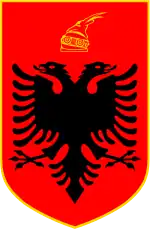 |
| Timeline |
Sources
- Brahaj, Jaho (2007). Flamuri i Kombit Shqiptar: origjina, lashtësia. Enti Botues "Gjergj Fishta". ISBN 9789994338849.
- Elsie, Robert (2010). Historical dictionary of Albania. Lanham: Scarecrow Press. ISBN 978-0-8108-7380-3. OCLC 454375231.
- Ermenji, Abas (1968), Vendi që zë Skënderbeu në historinë e Shqiperisë, Paris: Komiteti Kombëtar Demokrat 'Shqipnija ë Lirë', OCLC 504152562
- Schmidt-Neke, Michael (1987), Enstehung und Ausbau der Königsdiktatur in Albanien, 1912-1939, Oldenbourg Wissenschaftsverlag, ISBN 978-3-486-54321-6, retrieved 5 February 2012
- Jelavich, Barbara (1999) [1983], History of the Balkans: Twentieth century, vol. 2, Cambridge, United Kingdom: The Press Syndicate of University of Cambridge, ISBN 978-0-521-27459-3
- Vickers, Miranda (1999), The Albanians: a modern history, I.B.Tauris, ISBN 978-1-86064-541-9
- Nosi, Lef (2007), Dokumenta historike për t'i shërbye historiës tone kombëtare., Tirana: Instituti i Historisë, ISBN 978-99956-10-04-3, OCLC 230208965, archived from the original on 2011-05-07
- Giaro, Tomasz (2007), "The Albanian legal and constitutional system between the World Wars", Modernisierung durch Transfer zwischen den Weltkriegen, Frankfurt am Main, Germany: Vittorio Klosterman GmbH, ISBN 978-3-465-04017-0